| Portrait | King | Regnal dates | Succession and notes |
|---|
| Sellwood (1971–80) | Assar (2011) | Daryaee (2012) | Dąbrowa (2012) |
 | Arsaces I
Aršak | 247–211 BC | 247–217 BC | Founder of the Arsacid dynasty. Conquered the region of Parthia from the Seleucid satrap Andragoras. |
 | Arsaces II
Aršak | 211–191 BC | 211–185 BC | 211–191 BC | 217–191 BC | Son of Arsaces I. |
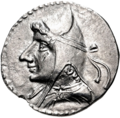 | Priapatius
Friyapat | 191–176 BC | 185–170 BC | 191–176 BC | Grandson of a brother of Arsaces I. Priapatius may have inherited the throne over more direct descendants of Arsaces II due to Arsaces II perhaps not having any children, any possible children being underage, or perhaps because he was deemed able by Arsaces II and thus designated as heir. |
| —Unknown king I— | — | 170–168 BC | — | Grandson of Arsaces II. Per Assar's chronology, Priapatius would have designated this figure as his heir over his own sons. |
 | Phraates I
Frahāt | 176–171 BC | 168–164 BC | 176–171 BC | Eldest son of Priapatius, reigned briefly before dying and being succeeded by his brother Mithridates I. Phraates I is known to have had sons, perhaps because Phraates I himself designated Mithridates to be his successor, considering his brother to be more capable than his sons. |
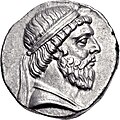 | Mithridates I
Mihrdāt | 171–132 BC | 164–132 BC | 171–138 BC | 171–132 BC | Son of Priapatius. Mithridates I's conquests in Persia and Mesopotamia, and even further, transformed the regional Parthian kingdom into a true empire. Attributed the title King of Kings by Babylonian cuneiform records. |
 | Phraates II
Frahāt | 132–127 BC | 138–127 BC | 132–126 BC | Son of Mithridates I. Initially under the regency of his mother, Rinnu, on account of his young age at the time of his father's death. |
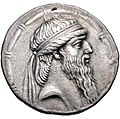 | Artabanus I
Ardabān | 127–124 BC | 127–126 BC | 127–124 BC | 126–123/122 BC | Son of Priapatius. |
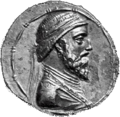 | Artabanus (II) [a]
Ardabān | — | 126–122 BC | — | Son of Artabanus I. Based on the work of Roman historian Justin, scholars traditionally assume that Mithridates II immediately succeeded his father Artabanus I, though Assar and some other scholars hold that coinage and cuneiform sources suggest an expanded line of succession, with Artabanus (II) possibly having been mistakenly conflated with his father of the same name. |
 | —Unknown king II— | 122–121 BC | Son of Artabanus (II). Proposed by Assar based on a set of coins traditionally attributed to Mithridates II. Per Assar, the coins depict a youthful and beardless ruler, which conflicts with the fully bearded and older figures depicted on the coins of Artabanus I and (II), and Mithridates II, suggesting a king between them. |
 | Mithridates II
Mihrdāt | 124–91 BC | 121–91 BC | 123–88 BC | 122–91 BC | Son of Artabanus I or Priapatius. First Parthian ruler who is confidently attested as having officially assumed the title King of Kings. |
 | Gotarzes I
Gōtarz
[Rival king?] | 95–90 BC | 91–87 BC | 95–90 BC | 92–? BC [b] | Dates and genealogy disputed on account of the attribution of many of the coins being uncertain. Assar identifies him as a son of Mithridates II based on cuneiform sources and states that he succeeded his father in Babylonia. Daryaee identifies him as a grandson of Priapatius. According to Assar, Gotarzes's rule was contested by Sinatruces I in other parts of the empire. |
 | Mithridates III
Mihrdāt | — | 87–80 BC | — | Son of Mithridates II (according to Assar). |
 | Orodes I
Worōd | 90–80 BC | 80–75 BC | 90–80 BC | — | Genealogy uncertain: Assar supports Orodes I being a son of Gotarzes I, whereas Sellwood believes him to be a son of Mithridates II on account of Orodes I in his coins wearing the same crown as Mithridates. Daryaee also supports Orodes being a brother of Gotarzes. |
| —Unknown king III— | 80 BC | — | — | Obscure possible ruler, per Sellwood, only known through coinage. |
| —Unknown king IV— | 80–70 BC | 78/77–62/61 BC | Obscure possible ruler, per Sellwood and Assar, only known through coinage. |
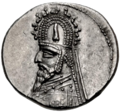 | Sinatruces I
[Rival king?] | 75 BC | 93/92–70/69 BC
(intermittently) | 77–70 BC | 88/87–71/70 BC | Son of Priapatius (Sellwood and Daryaee) or Mithridates I (Assar and others). Sellwood believes him to have reigned briefly in the 70s BC, whereas Assar and Dąbrowa believe he ruled intermittently from the 90s BC to the 70s BC as a rival king, perhaps gaining full sole power in the 70s BC. He is not mentioned in Babylonian cuneiform records. |
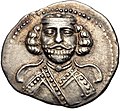 | Phraates III
Frahāt | 70–57 BC | 70/69–58/57 BC | 70–57 BC | 71/70–58/57 BC | Son of Sinatruces I. Recorded in Babylonian inscriptions, unlike his father. |
 | Mithridates IV
Mihrdāt | 57–54 BC | 58/57–55 BC | 57–54 BC | 58/57–54/53 BC | Son of Phraates III, murdered his father alongside Orodes II. |
 | Orodes II
Worōd | 57–38 BC | 58/57–38 BC | Son of Phraates III, aided his brother Mithridates IV in overthrowing their father, later deposed and murdered his brother to seize sole power for himself. |
 | Pacorus I
Pakur
[Junior co-ruler?] | 39 BC | — | Eldest son of Orodes II. Attributed a reign by Sellwood. The extent of his royal power—whether he was a junior co-ruler alongside his father, a sole ruler, or a rival king and rebel, or if he actually ruled in the first place, is not certain. |
 | Phraates IV
Frahāt | 38–2 BC | 38/37–2 BC | 38 BC – AD 2 | 38–3/2 BC | Son of Orodes II, chosen as successor by his father after the death of Pacorus I. Feeling his position to be uncertain, Phraates IV massacred the other children of Orodes II. |
 | Tiridates II [c]
Tīrdāt
[Rival king] | 29–27 BC | 27 BC | — | 31 BC | Part of the Arsacid dynasty but of uncertain lineage. Rival king supported by portions of the Parthian aristocracy against Phraates IV. Was able to secure control of the empire for some time, driving Phraates IV into exile, but was after a brief reign defeated by Phraates and himself driven into exile. |
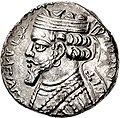 | Phraates V
Frahāt | 2 BC – AD 4 | 2 BC – AD 4/5 | AD 2–4 | 3/2 BC – AD 2 | Son of Phraates IV, ruled alongside his mother Musa. |
 | Musa | 2 BC – AD 4 | 2 BC – AD 4/5 | AD 2–4 | 3/2 BC – AD 2 | Formerly a Roman slave girl, wife of Phraates IV and mother of Phraates V. Ruled as the Parthian Empire's first and only ruling queen, together with her son Phraates V. |
 | Orodes III
Worōd | AD 6 | AD 6–8 | AD 6 | AD 4–6 | Part of the Arsacid dynasty but of uncertain lineage. Believed to have been crowned by Parthian aristocrats after the deposition of Phraates V, and possibly murdered after a very brief reign. Daryaee believes Orodes was a son of Phraates IV. |
 | Vonones I | AD 8–12 | AD 6–11/12 | Son of Phraates IV. |
 | Artabanus II
Ardabān | AD 10–38 | AD 11/12–39 | Uncertain lineage, possibly the son of a daughter of Phraates IV. Proclaimed as a rival king against Vonones I in c. AD 10. Defeated Vonones in AD 12, becoming the sole ruler of the empire. |
| [d] | Tiridates III
Tīrdāt
[Rival king] | AD 35–36 | — | AD 35–36 | Grandson of Phraates IV. Installed by the Parthian aristocracy at Ctesiphon as a rival king against Artabanus II, defeated by Artabanus after a brief reign. |
 | Vardanes I
Wardān | AD 40–47 | AD 38–46 | AD 40–47 | AD 39–45 | Son of Artabanus II. Fought with his brother Gotarzes II over the succession to the throne after the death of their father. Initially successful, reaching a compromise in that Vardanes was to rule the empire whereas Gotarzes was to rule Hyrcania. Possibly assassinated, whereafter Gotarzes became the sole ruler. |
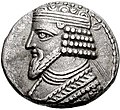 | Gotarzes II
Gōtarz | AD 40–51 | AD 44–51 | AD 40–51 | — | Son of Artabanus II. Fought with his brother Vardanes I over the succession to the throne after the death of their father. Sole ruler after the death of Vardanes I. |
 | Meherdates
Mihrdāt
[Rival king] | — | AD 49–50 | — | AD 49–51 | Son of Vonones I. Rival king against Gotarzes II. |
 | Vonones II | AD 51 | — | AD 51 | — | Uncertain lineage, possibly the son of a daughter of Phraates IV (and a brother of Artabanus II). Ruled briefly, perhaps only with tenuous control over the empire. |
 | Vologases I
Walgaš | AD 50–79 | AD 50–54; 58–77 | AD 51–78 | AD 51–78/79 | Uncertain lineage, possibly the son of Vonones II or a brother of Gotarzes II (i.e. a son of Artabanus II). If Vologases I was a brother of Gotarzes II, Vonones II was probably a rival king, rather than Vologases I's direct predecessor. |
 | Vardanes II
Wardān
[Rival king] | AD 55–58 | AD 54–58 | AD 54/55 | Son of Vardanes I. Revolted against Vologases I in Seleucia, ruling there perhaps for several years in opposition to Vologases. |
 | Pacorus II
Pakur | AD 75–110 | AD 78–120 | AD 78–105 | AD 78–110 | Son of Vologases I. Proclaimed co-ruler by his father while Pacorus II was still a child. Succeeded as sole ruler upon his father's death. |
 | Vologases II
Walgaš
[Rival king] | AD 77–80 | AD 76/77–79 | — | Son of Vologases I. Rival king against Pacorus II. The existence of Vologases II is based on coinage, but his historicity has been questioned as the coins might be assignable to Vologases I instead. |
 | Artabanus III
Ardabān
[Rival king] | AD 80–82 | AD 79/80–85 | AD 80–90 | — | Son or brother of Vologases I. Rival king against Pacorus II, apparently with little support outside of Babylonia. Alternatively, if he was Pacorus II's uncle rather than brother, he may have ruled as a legitimate king during Pacorus II's minority. |
 | Vologases III
Walgaš | AD 105–147 | AD 111–146 | AD 105–147 | AD 110–147 | Son of Pacorus II. |
 | Osroes I
Husraw
[Rival king] | AD 109–129 | AD 108/109–127/128 | AD 109–129 | — | Son of Pacorus II. Rival king against Vologases III, in control of the Parthian Empire's western heartlands for decades. Briefly deposed by the Romans after Emperor Trajan's victory over Parthia in AD 116, before regaining his throne. |
 | Parthamaspates
[Roman puppet king] | AD 116 | — | Son of Osroes I. Proclaimed as puppet king by the Romans, but was defeated and expelled by his father shortly after the Romans left. |
 | Sinatruces II
[Rival king] | — | AD 116 | — | Son of Mithridates V (r. 129–140). Possibly a rival king against Parthamaspates, alongside his father. Only mentioned by the Byzantine historian John Malalas, with some uncertain coin attributions, thus unclear if Sinatruces II existed in the first place. [47] |
| —Unknown king V—
[Rival king] | AD 140 | — | Part of the Arsacid dynasty but of uncertain lineage. Rival king against Vologases III, but little is known of him. |
 | Mithridates V
Mihrdāt
[Rival king] | AD 129–140 | AD 128–147 | AD 129–140 | Uncertain lineage. Rival king against Vologases III, but little is known of him. May have earlier claimed the throne against Parthamaspates in AD 116/117, together with his son Sinatruces II. [47] |
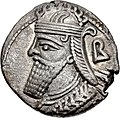 | Vologases IV
Walgaš | AD 147–191 | AD 147–191/192 | Son of Mithridates V. King after the deaths of Vologases III and Mithridates V. |
 | Osroes II
Husraw
[Rival king] | AD 190 | AD 190–208 | — | Part of the Arsacid dynasty but of uncertain lineage. Rival king against Vologases IV, and possibly also against Vologases V, depending on the length of his revolt. May have ruled in Parthia, with Vologases IV and Vologases V controlling Mesopotamia. |
 | Vologases V
Walgaš | AD 191–208 | AD 191–207/208 | AD 191–208 | AD 191/192–208 | Son of Vologases IV. |
 | Vologases VI
Walgaš | AD 208–228 | AD 207/208–221/222 | AD 208–228 | AD 208–221/222 | Son of Vologases V. Fought for control over the empire with his brother, Artabanus IV, and appears to have lost control of most of it by c. AD 216. Vologases VI might still have ruled parts of the empire by AD 228, as coins with his name are known from that year. |
 | Artabanus IV
Ardabān | AD 216–224 | AD 212–224 | AD 216–224 | AD ?–224 [e] | Son of Vologases V. Fought with his brother Vologases VI for the throne, achieving control of the empire by c. AD 216. Artabanus IV was the last king of the Parthian Empire, being defeated by Ardashir I, who founded the Sasanian Empire, in AD 224. |
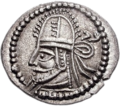 | Tiridates IV
Tīrdāt
[Rival king?] | AD 216–224? | — | Part of the Arsacid dynasty but of uncertain lineage. The existence of Tiridates IV is not clear. Sellwood bases the existence of this king on a second row of inscriptions on a coin of Artabanus IV, which appears to include the name Tiridates, but this reading of the text is dubious and contested. |














































